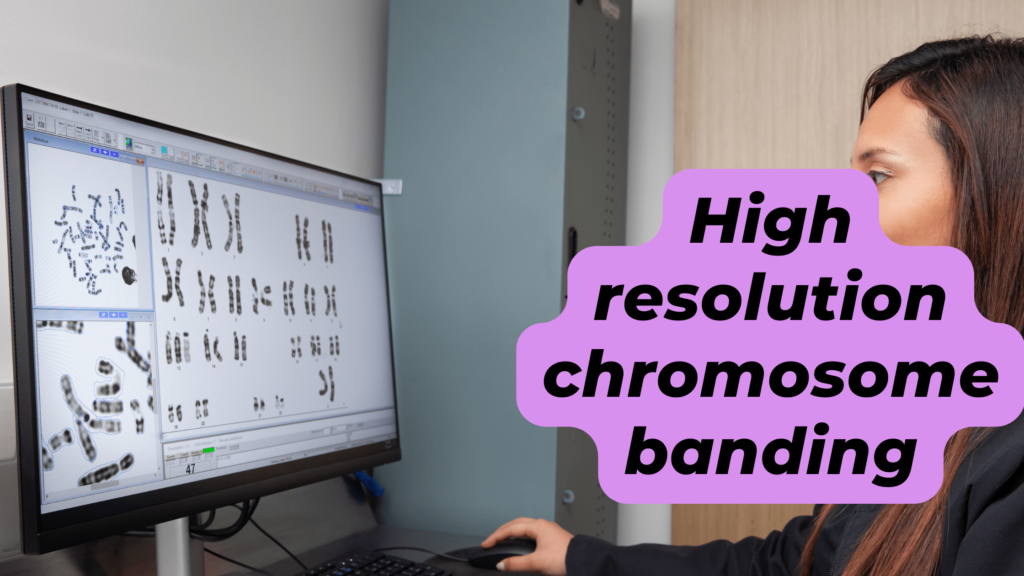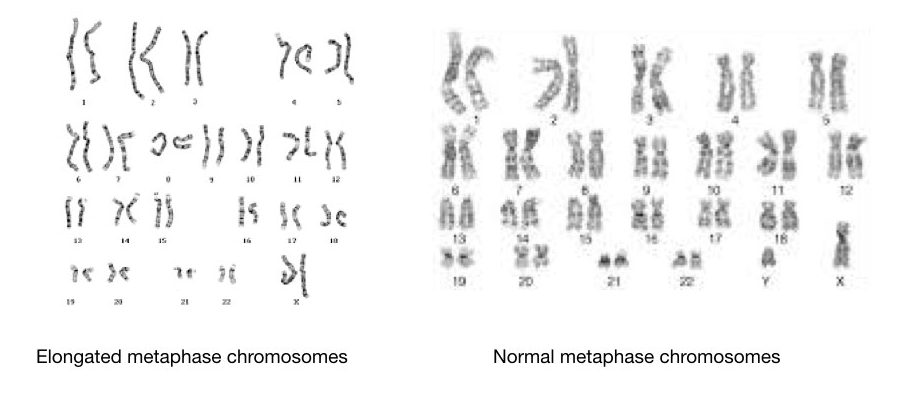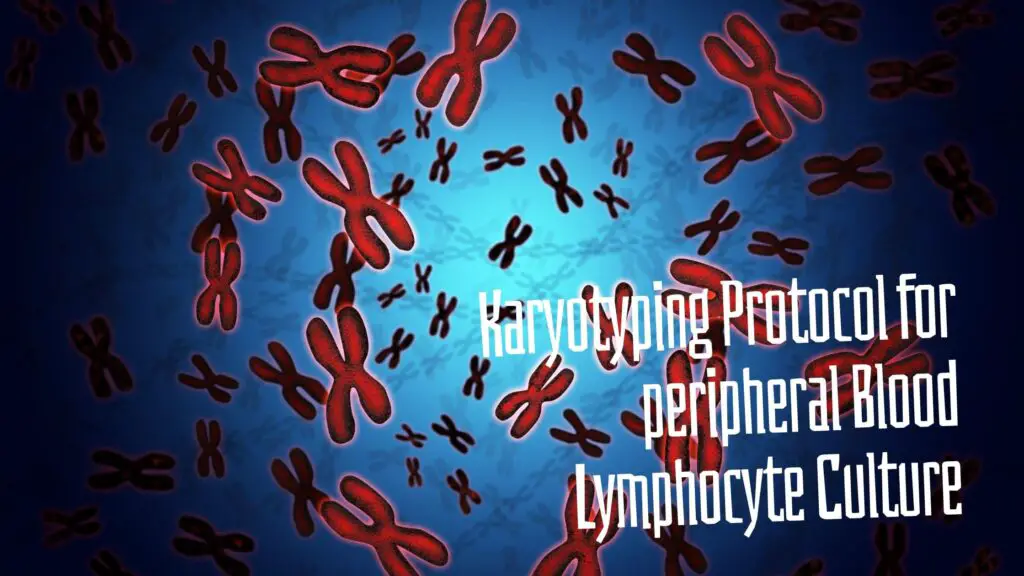Learn how to use Ethidium Bromide in karyotyping to improve chromosome banding and study structural chromosomal abnormalities effectively.

Karyotyping is a technique to study chromosomes. It’s a well-known and widely used diagnostic method. In this technique, cells are cultured, and harvested and metaphase chromosomes are separated.
Using staining and banding techniques, the metaphase plates can be observed. GTG banding is the most common technique to study chromosomes. However, this conventional approach has a serious limitation.
Karyotyping has a limited resolution power. Chromosomes look shorter, condensed and with fewer bands. So it restricts the resolution. One can only study numerical alterations effectively.
Major deletions and duplications will remain un-studied using a traditional karyotyping approach. Interestingly, adding one extra chemical– EtBr can help to improve the chromosome banding size and resolution.
I have years of experience working with karyotyping. In fact, the major technique that I selected for my PhD was karyotyping. We performed thousands of karyotyping in our research group.
I’m sharing my knowledge and research experience here. In this article, I will explain how adding Ethidium Bromide can improve karyotyping resolution.
Disclaimer: Information provided here is collected from peer-reviewed resources and re-presented in an understandable language. All the sources are enlisted at the end of the article.
related article: A Brief Introduction To Cytogenetics [Karyotyping, FISH and Microarray].
Key Topics:
EtBr For High-Resolution Chromosome Banding:
DNA supercoiling is a process of DNA packaging on chromosomes. It shrinks DNA into the most compact form and arranges it on chromosomes. Resultantly produced heterochromatin and euchromatin are highly and loosely condensed regions on chromosomes, respectively. Either region is seen as light and dark stain regions during GTG banding.

Metaphase chromosomes are in the most condensed form– in a highly supercoiled state. Due to this, we can effectively analyze it. Chromosome condensation restricts us from studying structural variations as it’s in the most compact form.
Ikeuchi T (1984) explained that during Lymphocyte culture, adding EtBr at a certain stage arrests chromosomes at early prometaphase. Meaning, that we can get more loosened, less condensed and elongated chromosomes.
EtBr-Ethidium bromide is a dsDNA intercalating fluorescent dye. It binds to dsDNA, particularly at a DNA major groove region and emits fluorescence. However, here in karyotyping, it plays a totally different region.
| Chemical | Ethidium bromide |
| Abbreviations | EtBr, etbr or EB |
| Chemical formula | C21H20N3Br |
| Molecular weight | 394.4 |
| Fluorescence | Orange |
| Toxic | Yes |
| Appearance | Dark red |
| Availability | Crystalline form |
| Odor | odorless |
| Property | DNA intercalating agent |
In karyotyping, we use EtBr for high-resolution chromosome banding and not for utilizing its fluorescence properties. EtBr intercalates between DNA bases, prevents DNA condensation, creates more space between bases and elongates chromosomes.
Ronne M (1989) demonstrated that adding EtBr, actinomycin D or Hoechst 33258 prevents chromosome contraction and condensation. This means that we can analyze more chromosome bands thereby chromosomal rearrangements, if any.
So metaphase phase cells are less important for high-resolution banding. Adding EtBr increases the number of prophase and prometaphase cells. So we will get more elongated chromosomes and chromosomal bands during GTG and R-banding (Ronne M, 1989).
Studies suggest that using EtBr can achieve 550 to 850 bands per haploid genome. Scientists can study larger structural chromosomal alterations like deletions and duplications which previously couldn’t be studied using metaphase chromosomes (Jager P & Kuhn-Schlage, 1984).
However, EtBr alone can’t produce a high-resolution karyotype. Adding colcemid during the procedure helps arrest chromosomes at a particular stage by preventing spindle fiber formation.
In the final step, hypotonic treatment enlarges cells and produces well-separated chromosomes. We were working on a lymphocyte culture. EtBr’s role is proven in lymphocyte cultures.
However, studies also suggest that it can be used for high-resolution karyotyping from bone marrow and solid tumors (Tomiyasu & Testa, 1988), Burkitt’s lymphoma cells (Ikeuchi, 1984) and amniotic fluid (Jager P & Kuhn-Schlage, 1984).
How to use EtBr in karyotyping?
Reviews, expert answers on ResearchGate and our own research suggest that adding EtBr and Colcemid at the 70th hour of cell culture can work effectively for 72 hours of cell culture.
You can add EtBr and colcemid at the 71st and 72nd hour, respectively or both at the 71st hour. Ideally, 0.02 µg/ml EtBr and 7 µg/ml colcemid have been added to the cell culture.
After incubation for 2 hours, cells are processed for hypotonic treatment, harvesting and GTG banding. To know more about the protocol. Read this article: Protocol for Peripheral Blood Lymphocyte Culture.
EtBr is a potentially toxic, irritant and carcinogenic. Care must be taken while handling EtBr. Lab personnel have to take training to handle and dispose of EtBr.
Read more: Why and How to Use Ethidium Bromide in Gel Electrophoresis?
Wrapping up:
Karyotyping is an important diagnostic and prenatal testing technique. It has been used to study numerical and structural chromosomal abnormalities for decades. However, improved high-resolution banding by EtBr allows us to study more structural alterations.
I hope you like this small piece of well-researched and well-reviewed article. Please share it with your fellow scientists. Do let me know in the comment if you have any questions.
Sources:
Ikeuchi T. Inhibitory effect of ethidium bromide on mitotic chromosome condensation and its application to high-resolution chromosome banding. Cytogenet Cell Genet. 1984;38(1):56-61. doi: 10.1159/000132030.
Tomiyasu T, Testa JR. Application of ethidium bromide for high-resolution banding analysis of chromosomes from human malignant cells. Stain Technol. 1988 Mar;63(2):83-91. doi: 10.3109/10520298809107166.
Jäger P, Kuhn-Schlage C. A simple method for high resolution banding of chromosomes in amniotic fluid cells. Hum Genet. 1984;65(3):273-7. doi: 10.1007/BF00286516.
Rønne M. Chromosome preparation and high resolution banding techniques. A review. J Dairy Sci. 1989 May;72(5):1363-77. doi: 10.3168/jds.s0022-0302(89)79243-2.
Misawa S, Horiike S, Taniwaki M, Abe T, Takino T. Prefixation treatment with ethidium bromide for high resolution banding analysis of chromosomes from cultured human bone marrow cells. Cancer Genet Cytogenet. 1986 Aug;22(4):319-29. doi: 10.1016/0165-4608(86)90024-5.
